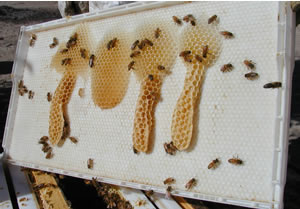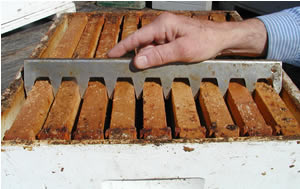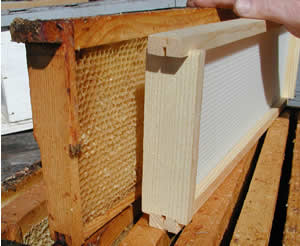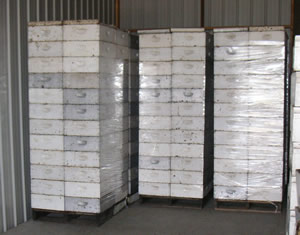DRAWING WAX:
Starting a beehive
totally on foundation isn't easy but can be done under the right conditions.
Beginning beekeepers don't have much choice because they start with new
equipment and suppliers don't sell drawn combs. Buying someone else's
used equipment carries the risk of it being contaminated with foulbrood.
In the end, you may be better off to stick to new equipment, get it drawn
out and avoid the risk of contamination.
I had this unpleasant experience initially in the first few hives purchased when getting started. Looking back, I guess a really smart beekeeper knew how to get rid of his contaminated equipment for fun and profit! Hey, what did I know, I was just starting.
Foulbrood is spread by tiny spores that remain viable for years and are only killed by radiation or extreme heat (fire). If you're not familiar with foulbrood and how to spot it - get one of the reference books mentioned previously in March (page 2) and learn about it - before you to get an education the hard way!
Sorry to digress, but foulbrood is a disease that can consume your bees.
Drawing wax or building comb is simply the process of the bees turning foundation of any type into useable comb as seen on the previous page in fig 10. Bees make wax from honey. When they are building comb the honey goes into the wax. This is why it's difficult to produce much if any honey from a new hive the first year when starting out on foundation. Young bees produce most of the wax which is secreted in small increments from wax glands on the underside of the bee. The little bits of wax are then worked together with the help of the bees mouth parts to form the familiar honey comb pattern.
Bees produce wax only when they have an abundance of food - in other words during a honey flow which is the best time to draw out new frames. If there is little or no honey flow, the other alternative is to feed the bees to promote comb building. But with little or no nectar coming into the hive, it can take gallons of sugar syrup to get the job done.
SPACING FRAMES:
New frames containing foundation should be pushed tightly together
to minimize the space between them. This encourages the bees to draw the
frame out in the desired direction rather than building their natural
hanging comb while ignoring your foundation. Despite this, they still
occasionally revert to their natural instinct to build hanging comb, fig
15. When this happens just remove the offending comb and let them try
again.
Placing a new frame (foundation) between combs already drawn out when possible will help minimize these missteps. It is helpful to rearrange the frames from time to time as the bees draw them out. It seems to motivate the bees to draw out the comb when they find foundation between two drawn frames. Swarms are good at drawing comb, probably because they are prepared to build a hive - comb and all - from scratch when they finally arrive at a suitable location.
FRAME SPACING
FOR HONEY PRODUCTION:
Once frames are drawn
out the comb depth can be increased by adding a small amount of additional
space between them. This is desirable in the case of a honey super because
it puts the same amount of honey in fewer frames. We typically use nine
frames in a ten frame box evenly spaced with the aid of the frame spacer
(fig 16). Additionally, the deeper comb makes the frame easier to uncap
- the first stem in extracting the honey. More on this in the next two
months (July and August).
A clever invention
is the "Powers" frame which accomplishes the same purpose as
described above by using an oversized end bar. The advantage is they are
self-spacing for 9 frames but with the large distance between foundations
initially, they are more trouble to get drawn out.





